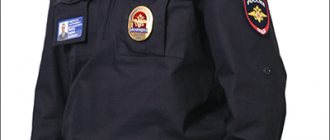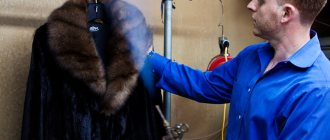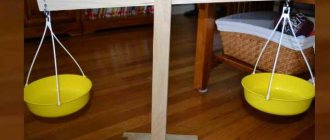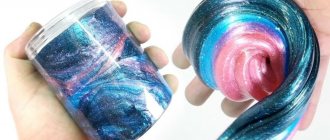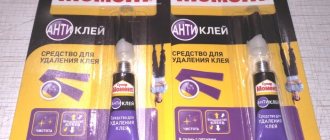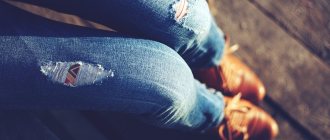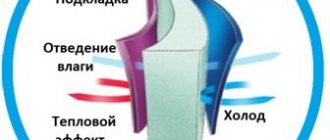Stripes and chevrons came into our lives quite a long time ago, but it is worth noting the fact that initially chevrons were used only by military personnel, so that other soldiers and officers could distinguish them. With the advent of football fans, especially the so-called. “Near-footballers” patches became part of the everyday life of teenagers who supported their team. For them it is also a kind of sign of difference from “strangers”. Our production makes patches for both civilians and military personnel, so today we will tell you how to sew a patch on your clothes yourself.
Let's say you have a patch made by us, but you don't know how to attach it to your clothes. There are two ways: machine and manual. We do not recommend the machine version; unwanted stitches may remain on the patch; they will be visible on the outside and on the inside and will ruin the whole idea. Our master class is dedicated to the second option, hand sewing. This method is available even to those who have never picked up a needle. In addition, we will tell you about a special hidden stitch that will help make the fastening invisible. With a little patience and accuracy, you can sew a patch onto your clothes!
So, we will tell you about all the steps that you need to go through in order to sew on your chevron.
A useful item with a lot of purposes
It would seem that what could be important in a banal patch? If everything is clear with the police and military, because this is part of the uniform, then why do civilians need such additions?
In fact, everything is very simple. There are a number of reasons for this:
- Belonging to subcultures. Often the most active in this regard are punks and lovers of alternatives. They are literally ready to cover and paste over everything, attaching the names of their favorite bands, abbreviations and other distinctive signs.
- Stylish things. Modern girls pay a lot of attention to fashion trends. Today, parkas and bright synthetic jackets are replete with badges and stripes.
- Reluctance to part with a favorite thing. Some people are very reluctant to part with their favorite things. Just because your jeans or favorite sweatshirt are worn out doesn’t mean it’s time to throw it away. A cool patch or applique that hides a defect may be quite appropriate.
Important! To prevent the design from being displaced by the iron during the gluing process, it should be attached using safety pins.
Some Caveats
Mostly young, fairly brave girls who love to be the center of attention decorate their clothes with stripes. And although they are most often used to decorate everyday clothes, you can also find stripes on business suits and even evening dresses.
Still, you shouldn’t overdo it when using stripes as a decorative element, especially for women who are not of a young age.
By showing imagination, accuracy and perseverance, you can turn a completely ordinary item from your wardrobe into a fashionable and stylish outfit that will invariably be the center of attention of others.
Methods for making chevrons
The manufacturing features of chevrons have different methods of fixation to the product. Quite often, chevrons are used to replace regular embroidery on difficult-to-embroider fabric, such as lacoste or knitwear. This happens due to the poorly visible embroidery on the material described, as it is lost in the soft fabric - embroidered chevrons will look great and quite attractive. To strengthen and strengthen the product, you need to fix the embroidered chevron from the inside of a uniform jacket or other clothing with an adhesive solution. The adhesive base is used when gluing the chevron to the product using a hot iron. If you have a heat press, you can use it. Embroidered patches are of great importance for hats. Due to the miniature embroidered area, the embroidery process is too difficult. The process of sewing or gluing ready-made distinctive signs embroidered with bright threads saves the day. By using special glue, the prepared embroidered detail is placed on the cap, making it luxurious and magnificent. These manipulations can be performed on any small product; the embroidered patch is fixed easily, without complications of the work being done.
Benefits of an embroidered patch
Embroidered chevrons have the following advantages:
- Colorful, great color to match the base.
- Thread coloring is resistant to temperature changes and repeated washing, cleaning and wear.
Tell your girlfriends
Support the Womee project, because we put our whole soul into it - share the article with your friends by clicking on one of the buttons below
The peculiarities of making chevrons mean that they are attached to stretchy fabric and then sewn onto the product. And the quality of the finished product depends on the level of hooping. They have a huge number of varieties.
The uniforms of many organizations and departments are decorated with a sewn chevron - the insignia of various professional corporations, denoting various corporate characteristics.
How to sew an emblem on a school uniform and vest?
Currently, in our country there are no uniform rules regarding the type of school uniform. The need for a uniform is determined by each educational institution independently. An increasing number of schools are switching to compulsory school uniforms, and each school has its own. One of the most common items of uniform is a school uniform called a vest. A distinctive feature that emphasizes the students’ belonging to a particular educational institution, along with the color of the uniform, is a patch with the symbols of the school. The emblem can be made by embroidery in a specialized workshop or in the form of an applied chevron .
Application of insignia
The chevron is part of the uniform equipment of various structural units:
- police
- police
- military
- security guards
- some enterprises
Often, insignia are used for uniforms of staff of huge network marketing, hypermarkets, or are used to designate brands. The chevron is used to distinguish enterprises or law enforcement agencies, or for the purpose of advertising a certain brand. Consumers quickly recognize by signs which company or power structure the employees represent. Clothing decorated with insignia looks representative and respectable. Sportswear is also decorated with certain signs that distinguish different sports enterprises.
Lemon
How to make a patch? The easiest way to make it is to embroider a beautiful design on thick material. For example, you can make an applique in the shape of a lemon. An outline should be cut out of felt. It can be a whole lemon or a slice. Cut out the felt and stitch it. The most convenient way to do this is with a sewing machine or overlocker.
A beautiful edge of the patch can be made by hand, for example, by crocheting the product or stitching it over the edge. If you are making an applique in the shape of a lemon, then you should embroider a highlight on the product. If the patch looks like a slice, then it is necessary to make white veins. They can also be embroidered in two ways: either by machine or by hand. Don't forget to use a few stitches to create the bones.
Historical standards
According to historical standards for how to sew a chevron on a sleeve, the type of location and type of it were prescribed differently in each unit. For example, the crossed anchor of the navy was usually sewn on the left sleeve, a shield with the image of the Russian flag and the coat of arms of the ground forces was placed on the left and right sleeves. General field uniform patches were placed on the left.
Chevrons on sleeves
At the moment, there are non-standardized rules that prescribe how the chevrons should be located. They indicate information on how the stripes should be located and where to sew them. However, some private enterprises change the rules for their own reasons. There are no uniform requirements for the shape and how to properly sew chevrons and at what distance.
Various legislative acts contain only some information about the appearance of a person while performing official duties. Such documents indicate that the appearance should emphasize the status of the object.
Historical location
Advantages and disadvantages of handmade patches
Today, everything made by hand has special value. Patches are no exception to this rule. The advantages of such stripes include:
- unique design, because it is likely that a do-it-yourself patch will be the only one in the world;
- low cost due to the fact that remnants of previously used materials are often used to make the patch.
Among the disadvantages of such work, one can note the mandatory presence of experience in sewing, without which the work will not be accurate, and a significant investment of time.
Why do you need a thermal adhesive?
This patch is a lifesaver for those who want to refresh their boring wardrobe without significant financial investments.
Thermal decal is an inexpensive and effective way to revive your favorite item. This is especially true for children's clothing. Images of your favorite fairy-tale characters will help you disguise stains and cuts on children's T-shirts and save the family budget.
Using thermal stickers, you can diversify not only your wardrobe, but also your interior. If you stick a patch on decorative pillows, curtains, bedspreads, the interior will immediately turn into exclusive.
How to sew a patch on clothes?
First you need to position the patch correctly and attach it with small pins. You definitely need to try on the item to make sure that the place is chosen correctly.
Editor's choice: Fashionable perfumes 2022: fragrances depending on the time of year
If you are satisfied with the location of the patch, you can proceed directly to sewing on the emblem. This should be done with small stitches, without stretching or creasing the fabric. At the end of the work, you need to try on the item again. If the fabric wrinkles, it is better to rip off the patch and do the whole job again.
Where can I buy
Often we come across clothes with existing stripes, however, you can diversify your outfits yourself. With the development of consumption, the market offers a lot of options for purchasing the desired product.
The easiest and most affordable way was and remains purchasing in stores:
- Hobby
- Handicraft
- Sewing accessories
- Specialized themed stores with paraphernalia for anime, bikers, rockers, etc.
However, there is not always time and opportunity to go to the store, so online shopping has been gaining great demand lately. On the vastness of the World Wide Web, there is a huge selection of stripes for every taste. Thanks to such modern technologies, the purchase is completed in a few minutes and delivered to your home.
The most popular Internet sites:
- Leonardo is a huge supermarket of goods for hobbies and creativity, with more than 90 thousand items of goods. All products are divided into categories, and a convenient search system makes it easy to find the item of interest.
- AliExpress is a virtual store, the assortment of which is presented by manufacturers from China. A large number of different categories, including a hobby and crafts section. Purchases are carried out both wholesale and retail.
- Handicrafts is a hypermarket focused on working with textile products. The minimum order amount is from 400 rubles, for wholesale purchases there is a system of discounts.
Do-it-yourself patch on clothes: manufacturing features
- Take the main fabric and iron it thoroughly to remove excess creases and folds. After this, it is advisable to use the hoop throughout the entire work to ensure even embroidery.
- If your fabric is very different from the color palette of the threads you plan to embroider with, then draw and paint a sketch of the embroidery with slightly diluted gouache or acrylic paint.
- Let the paint dry and adhere thoroughly to the fabric base.
- If desired, the paint can be sprayed with varnish for stability.
- Start your satin stitch with one spot of color and then move on to the next. The stitches need to be done as close as possible so that the applied paint does not even show through them. This is the only way you will receive a high-quality product that you will not be ashamed to use in life.
- So, step by step, fill the entire patch with threads, and then complete the entire look with a contrasting color edging stitch.
- Cut out the embroidery with a small allowance of 5-8 millimeters.
- Then saturate the fabric edge with glue and fold it over to the wrong side so that it is not visible. The same thing must be done with protruding threads.
- How to make patches on clothes with your own hands so that they look really cool? Add slight wear or highlights in some areas using layering stitches or simple paint.
Now you can decorate all your clothes, since making stripes on clothes with your own hands will be very simple and quick!
Interesting views
DIY patches on clothes come in a variety of varieties. From pin brooches to fabric and design ideas. After all, the most important thing is not the material used, but the idea!
So you have a huge range of choices to choose from to get the perfect patch for you. Firstly, you can change the base, since in its place there can be felt, denim, leather and even thick cardboard.
Secondly, this is the material for doing all the work. The patch can be made not only with floss threads, but also with sequins, beads, seed beads or pieces of fabric.
In addition, there are just as many variations in attaching the patch to clothing. It uses pins, adhesive tape, and the option of instant manual stitching.
After we have discussed all the possible options, it’s time to tell you how to make patches on clothes with your own hands.
Popular models
Popular models include the following:
- Fabric overlays applied to special clothing of courier services, employees of catering establishments and other commercial organizations, indicating the logo emblem;
- Stripes on children's uniforms worn by pupils of children's educational institutions;
- Children's overlays that help the child stand out among his peers in kindergarten;
- Stylish and fashionable stripes that allow you to assign a person to a certain group;
- Chevrons on the clothing of military personnel, as well as patches on the uniforms of employees of private security companies;
- Medical pads are used by employees of medical institutions;
- Sports overlays: applications representing a variety of sportswear brand names, for example, Adidas;
- Fabric pads used by fans. As a rule, they display football teams, for example, Spartak.

